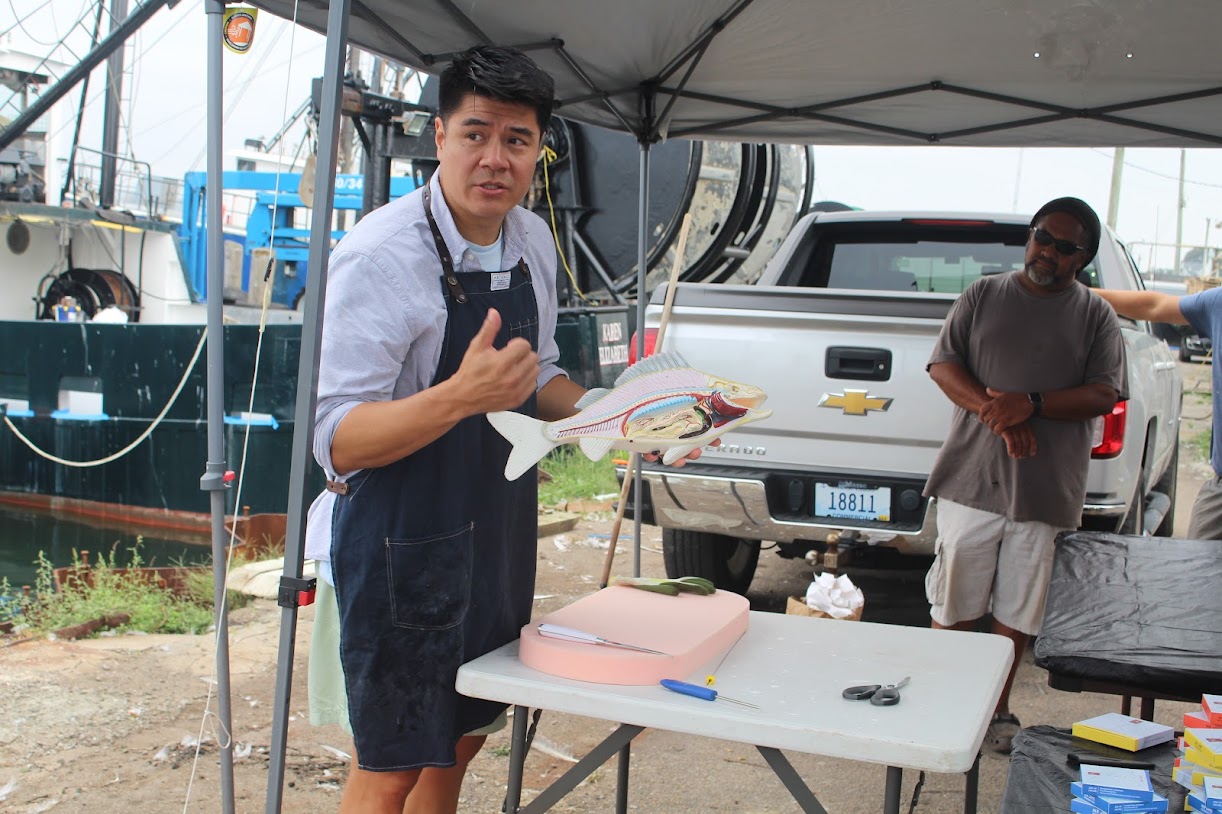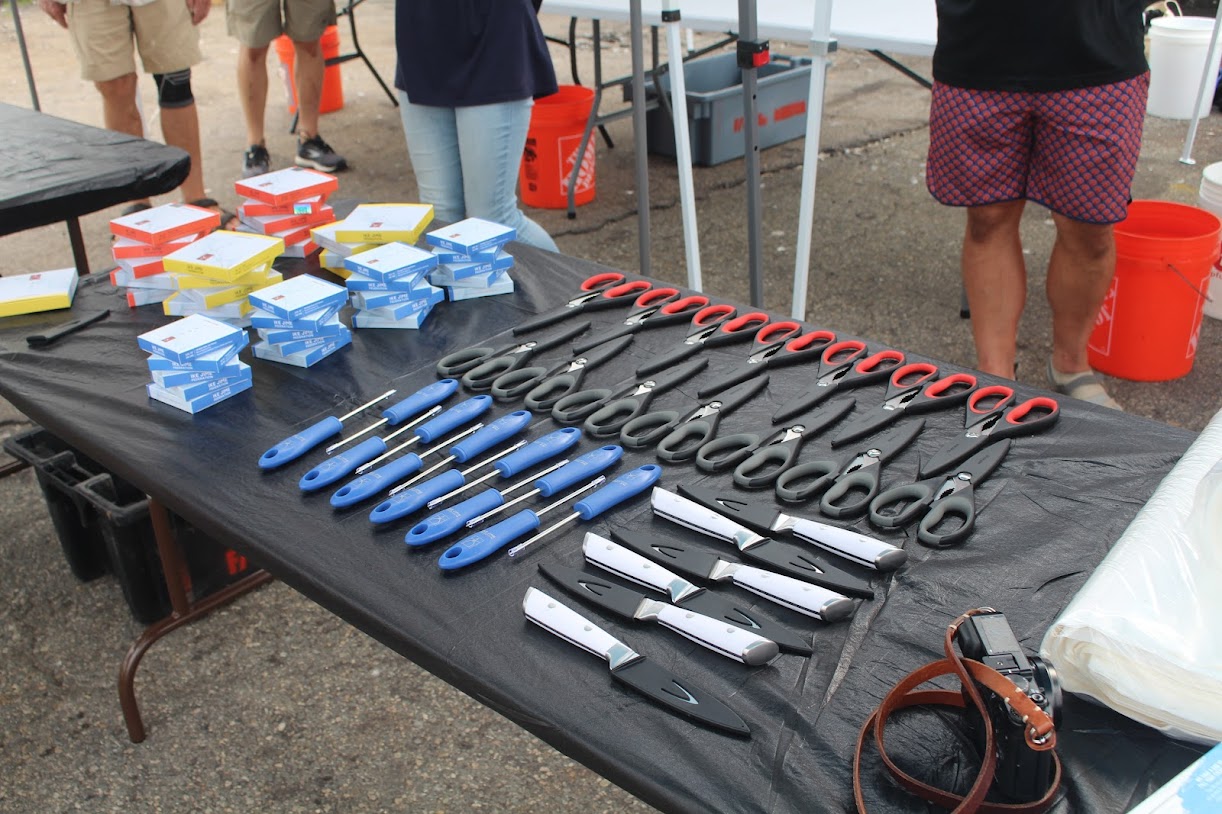Practice could benefit local fisheries, help with sustainability
By Colleen Cronin / ecoRI News
staff
 |
| Andrew Tsui, president of the Ike Jime Federation, shows where the brain and spinal cord of a fish are using a plastic model. |
Hirotsugu Uchida used to travel to Massachusetts to visit a Japanese grocery store whenever he wanted to get high-quality fish he knew he could safely eat raw.
So, when Fearless Fish Market opened in Providence, serving high-quality, local fish, he quickly became a frequent patron.
Although he is a professor of environmental and natural
resource economics at the University of Rhode Island, Uchida only started to
think seriously about how his own issue finding fresh fish could be applied to
his work when he started talking to Fearless Fish owner Stuart Meltzer.
Since wild fish are often caught in bulk and brought on
board already dead, the quality of their meat suffers, Meltzer said. But he
told Uchida about a method he said could help improve the freshness, taste, and
shelf stability of fish, and could also be used to promote underutilized
species. It’s called ikejime.
Uchida, who is Japanese, knew a little about the method for killing and preparing fish and that it was often connected to sushi, but in conversations with Meltzer, he started to realize that it could be so much more, and he started applying for grants.
Ikejime is a Japanese term for the immediate killing of a
live fish, according to Andrew Tsui, president of the Ike
Jime Federation, an organization that trains individuals on how to
perform the method.
“The sort of core principle is that the fish cannot stress, primarily because that stress will have really serious, negative consequences on the eating quality of that fish over time,” Tsui said.
The process can be modified and mechanized, but Tsui said it has four basic steps: 1) killing the fish with a hit to the brain, 2) bleeding it, 3) rupturing its spinal cord, and then 4) placing it in an ice bath.
The steps are simple, but they have significant repercussions in the chemical processes happening in the fish’s flesh, which in turn impact its quality, Tsui said.
The spiking of the brain and the rupturing
of the spinal cord reduce stress and post-mortem movement, which can damage the
flesh through bruising and the buildup of chemicals such as lactic acid and
hormones. Bleeding and putting the fish in an ice bath prevents bacteria from
entering the fish and reducing its shelf life.
Tsui explained this process to a group of seafood
stakeholders at URI in September. One of the grants for which Uchida
successfully applied — the university’s Partnership for Research Excellence in Sustainable
Seafood grant — funded a two-day course on the method.
After a day of talking about ikejime and what it means,
participants drove to Narragansett to try the method themselves.
‘His heart is still beating’
Under tents set up at Point Judith, a display of brain
spikes, wires, knives, and scissors made up the participants’ workstations.
Lively fish caught the day before splashed participants who peered into their
coolers for a closer look.
To start, Tsui grabbed a black sea bass and placed it,
still flapping, on a spongy mat at his table.
“The first thing you are thinking about is limiting
stress,” he said. “You need to put it down immediately.”
 |
| Brain spikes, wires, knives, and scissors can all be used to perform the ikejime process. |
Feeling around for a notch near the eye that indicates where the brain is, Tsui explained that it might be in slightly different places depending on the species.
“Every fish is a little different,” he said.
“It’s like driving stick.”
“It’s a sea bass, they don’t have brains,” one of the
participants, Fred Mattera, executive director of the Commercial Fisheries
Center of Rhode Island, said, getting the others chuckling.
After Tsui found the proper spot, he drove the spike into
the fish’s brain. Its mouth opened up and its fins flashed; the fish was dead.
“His heart is still beating,” Tsui said, which would help
bleed the fish after he made a few cuts, quickly grabbing a knife and slicing
into the membrane of the gills and through the bone at the tail.
Tsui dropped the fish into a bucket of water to let it
bleed before bringing it back on the mat for the next step, paralyzing the
fish. Although already dead, the fish still has potential energy in its muscles
that could make it move around, like a chicken with its head cut off. To
prevent this movement, Tsui took out a thin wire, and went on a search for the
fish’s spinal cord.
“It’s like a piece of spaghetti,” he said, opening up the
cut to the fish’s tail and showing the participants where to insert the wire.
“We want to destroy the noodle.”
As the wire tunneled through the back of the fish, the
dead creature shuddered again, and its scales changed color, eliciting oohs and
ahhs from the crowd.
The last step, the slush bath, keeps the fish cool and
keeps bacteria away, though it also has the benefit of protecting the fish’s
meat.
“Fish haven’t experienced gravity before,” Tsui said, so
keeping them in slush that’s not too icy can prevent compression.
With the demonstration over, it was time for the
participants to try their hand.
‘A dramatic improvement’
Before the participants got started, Tsui warned the
method required practice.
At first, that meant fish flopping around the plastic
tables and participants double-checking a plastic fish model Tsui brought to
see where the brain and spinal column really were.
Many of the participants, even lifelong fishermen, were
new to the method. Jason Jarvis, who has worn many hats in the industry — from
chef to commercial fisherman to charter captain — said that typically a fish is
caught whole and iced, and that’s it.
Mattera, who also spent years on commercial fishing boats, was also surprised and impressed by the technique. Because of the way it improves the quality of the fish meat, he said it could help small-boat fishermen sets themselves apart from larger operations.
Joe Letourneau, a fisherman out of Newburyport, Mass.,
has done just that. He was one of the few participants who had done ikejime
before and used the course as an opportunity to perfect his technique. As a
hook-and-line fisherman (versus a drag-netter), Letourneau’s catch comes aboard
alive, which has given him the chance to implement ikejime and fill a niche
that he saw in the market.
With the fish prepared using ikejime, the look, quality,
and shelf life is increased to the point that he can sell for a higher price,
he said.
For Meltzer, teaching local fishermen this technique and
having them adopt even a few of its tenets could help him get better quality
products for his customers at the fish market.
Consistent quality “is the biggest pain point” for his
business, Meltzer said. He is constantly seeking high-caliber fish, something
he can do because he works with lots of individual buyers and on a smaller
scale than large grocery stores. But despite his efforts, it’s still rare that
he’d get fish that’s as good as something that’s undergone ikejime, he said.
It’s rare, he said, to see fish come to his store already bled.
Because of the lack of consistency, Meltzer said he
sometimes has to turn to farm-raised fish. That way, he always knows what he’ll
get, but the complexity of flavor becomes a casualty.
“If we could get a wild product that’s consistently bled
and iced, that would be a dramatic improvement,” he said. “I’m hopeful this group
can be the genesis.”
At the end of the session, after the participants had
gotten used to the spikes and wires, Tsui brought out a ikejime filet fish and
compared it to the filet of a fish that had not undergone the process.
The latter was pinker and smellier.
“It’s a visible difference,” one fisherman said.
‘A benefit for them’
Tsui and Uchida also discussed the ways the ikejime
method fits into more sustainable fishing.
Although the process has been mechanized by some farm
fisheries, the time-intensive practice makes it more suitable for small
operations. While fishing in the United States is mostly about bulk, adopting
an ikejime practice could help fishermen pursue quality, Tsui said.
The increased shelf-life can also reduce food waste, as
Tsui explained that bleeding the fish can extend its use by days, and even
provide a better product by giving the fish time to age and develop more
flavor.
For Uchida, the big draw of the method is its potential
use for typically underutilized fish.
“The folks who are catching these locally abandoned
species, such as scup, but not getting a huge value out of it … if we can
increase the value of the fish, it will be a benefit for them,” he said.
In Japan, the prices for fish like scup handled using ikejime
is much higher than the price locals are getting for a similar fish in Rhode
Island.
Uchida said talking with fishermen who have shown such enthusiasm for trying the method makes him hopeful that it’s something that could work. He’ll be following up with stakeholders about the feasibility and effectiveness of it as the project continues and more trainings are held next year with grant money from the National Oceanic and Atmospheric Administration.
Kate Masury, executive director of Eating with the Ecosystem, also
participated in the course, and said she sees the potential for using the
method to help “celebrating the diversity of the seafood we have.”
Masury is working to teach culinary students at Johnson
& Wales University how to utilize ikejime. Students will be able to enter a
recipe competition, and the winner will be featured at a symposium next spring,
Uchida said at the end of the training day, while cooking a piece of ikejime
fish over a portable stove he’d brought to Point Judith.
Although Uchida cautioned that there is more to research
about ikejime, the fish did taste pretty good.